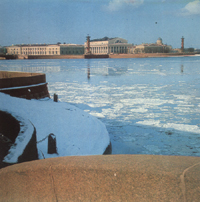The water treasures of St. Petersburg stands out of any comparison, as no city of the world can be proud of the river, similar to Neva.
Basis of water system of St. Petersburg is Neva-river; its length from Shlisselburg inlet of the Ladoga lake up to a mouth, at fall of Large Neva in the Neva inlet at the Neva gate of the Petersburg trade port, is 74 km. The distance from a source up to a mouth of Neva directly is 45 km. Neva has low coast within the limits of cities, about 2-3 meters on average. General height of fall of the river is only 4 meters. An average width is 400-600 m. An average speed of current in Neva is about 0,8-1,1 m/s. The dominant depth of Neva in city is 8-11m, and the greatest is 24 m (higher than the Litany bridge). Greatest width of Neva in St. Petersburg - 1250 m - is at the Neva gate of sea trade port and before Troicky (KIROV) bridge - 600 m, and the least - 340 m -is between two bridges Dvortcovy and The Bridge of Lieutenant Shmidt.
 . Thus, Neva is not only large, but even a medium-size river, regarding its length. But "the short " Neva carries as much waters, as Dnepr and Don together - about 80 km3annually! Despite of very small length, Neva has rather significant on the area pool: it includes about 50 thousand lakes. Except for them 3500 rivers concern to pool of Neva. Among them are such the giants, as Ladoga, largest in Europe, and Onega. The pool of Neva covers 281 thousand km2, the Ladoga lake covers more than 276 thousand km2,
more than 98 % of the area of all pool. A wide spit lays at Neva, consisting from ridges combined by boulders, separate stones and sandy banks. The depth of spit is about 2 m. To improve conditions of navigation, there have been done a so-called "Kroshinsky waterway ", with width about 90 m on the bosom and 120m on top. Neva has not terraces, and even no flood-lands. Neva has 26 inflows, the main of which are at the left - Ijora, Tosna, Mga, and on the right - Ohta and Black river.
. Thus, Neva is not only large, but even a medium-size river, regarding its length. But "the short " Neva carries as much waters, as Dnepr and Don together - about 80 km3annually! Despite of very small length, Neva has rather significant on the area pool: it includes about 50 thousand lakes. Except for them 3500 rivers concern to pool of Neva. Among them are such the giants, as Ladoga, largest in Europe, and Onega. The pool of Neva covers 281 thousand km2, the Ladoga lake covers more than 276 thousand km2,
more than 98 % of the area of all pool. A wide spit lays at Neva, consisting from ridges combined by boulders, separate stones and sandy banks. The depth of spit is about 2 m. To improve conditions of navigation, there have been done a so-called "Kroshinsky waterway ", with width about 90 m on the bosom and 120m on top. Neva has not terraces, and even no flood-lands. Neva has 26 inflows, the main of which are at the left - Ijora, Tosna, Mga, and on the right - Ohta and Black river.
In the beginning of December Neva usually freezes and stands with ice up to the middle of April. Neva begins freezing from a source, gradually being filled by ice, going from above Ladoga. But it happens, that in very cold years Neva becomes covered by ice for 1 day. The opening of Neva also begins at its sources and gradually, within 10-12 days reaches St. Petersburg. At return of colds opening and drifting of ice can stop for some days.
 But if cold winds blow from east, drifting of ice passes very quickly. Sometimes river is cleared for 1 day and all ice leaves the sea. In some days after first, Neva drifting of ice, the second one comes: there is an ice of the Ladoga lake. The ice comes, when the strong and cold northeast winds blow. A strong cold coincides with occurrence of the Ladoga ice. The Ladoga ice often forms ice jams, which cause floods. The floods of different force appear on Neva almost annually, and sometimes for several times per one year: so they are not connected to a season. Oftenly floods happen in the autumn and in the beginning of winter at strong gusty western wind.
But if cold winds blow from east, drifting of ice passes very quickly. Sometimes river is cleared for 1 day and all ice leaves the sea. In some days after first, Neva drifting of ice, the second one comes: there is an ice of the Ladoga lake. The ice comes, when the strong and cold northeast winds blow. A strong cold coincides with occurrence of the Ladoga ice. The Ladoga ice often forms ice jams, which cause floods. The floods of different force appear on Neva almost annually, and sometimes for several times per one year: so they are not connected to a season. Oftenly floods happen in the autumn and in the beginning of winter at strong gusty western wind.
There were more than 300 floods since the times of founding of city on Neva. It is accepted to consider all rises of water on more than 150 m above its average level as floods. The most awful floods were in 1777, when water has risen on 321cm,and in 1924, when water has risen on 380 cm.
 But if cold winds blow from east, drifting of ice passes very quickly. Sometimes river is cleared for 1 day and all ice leaves the sea. In some days after first, Neva drifting of ice, the second one comes: there is an ice of the Ladoga lake. The ice comes, when the strong and cold northeast winds blow. A strong cold coincides with occurrence of the Ladoga ice. The Ladoga ice often forms ice jams, which cause floods. The floods of different force appear on Neva almost annually, and sometimes for several times per one year: so they are not connected to a season. Oftenly floods happen in the autumn and in the beginning of winter at strong gusty western wind.
But if cold winds blow from east, drifting of ice passes very quickly. Sometimes river is cleared for 1 day and all ice leaves the sea. In some days after first, Neva drifting of ice, the second one comes: there is an ice of the Ladoga lake. The ice comes, when the strong and cold northeast winds blow. A strong cold coincides with occurrence of the Ladoga ice. The Ladoga ice often forms ice jams, which cause floods. The floods of different force appear on Neva almost annually, and sometimes for several times per one year: so they are not connected to a season. Oftenly floods happen in the autumn and in the beginning of winter at strong gusty western wind.
 . Thus, Neva is not only large, but even a medium-size river, regarding its length. But "the short " Neva carries as much waters, as Dnepr and Don together - about 80 km3annually! Despite of very small length, Neva has rather significant on the area pool: it includes about 50 thousand lakes. Except for them 3500 rivers concern to pool of Neva. Among them are such the giants, as Ladoga, largest in Europe, and Onega. The pool of Neva covers 281 thousand km2, the Ladoga lake covers more than 276 thousand km2,
more than 98 % of the area of all pool. A wide spit lays at Neva, consisting from ridges combined by boulders, separate stones and sandy banks. The depth of spit is about 2 m. To improve conditions of navigation, there have been done a so-called "Kroshinsky waterway ", with width about 90 m on the bosom and 120m on top. Neva has not terraces, and even no flood-lands. Neva has 26 inflows, the main of which are at the left - Ijora, Tosna, Mga, and on the right - Ohta and Black river.
. Thus, Neva is not only large, but even a medium-size river, regarding its length. But "the short " Neva carries as much waters, as Dnepr and Don together - about 80 km3annually! Despite of very small length, Neva has rather significant on the area pool: it includes about 50 thousand lakes. Except for them 3500 rivers concern to pool of Neva. Among them are such the giants, as Ladoga, largest in Europe, and Onega. The pool of Neva covers 281 thousand km2, the Ladoga lake covers more than 276 thousand km2,
more than 98 % of the area of all pool. A wide spit lays at Neva, consisting from ridges combined by boulders, separate stones and sandy banks. The depth of spit is about 2 m. To improve conditions of navigation, there have been done a so-called "Kroshinsky waterway ", with width about 90 m on the bosom and 120m on top. Neva has not terraces, and even no flood-lands. Neva has 26 inflows, the main of which are at the left - Ijora, Tosna, Mga, and on the right - Ohta and Black river.



